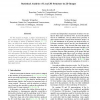Free Online Productivity Tools
i2Speak
i2Symbol
i2OCR
iTex2Img
iWeb2Print
iWeb2Shot
i2Type
iPdf2Split
iPdf2Merge
i2Bopomofo
i2Arabic
i2Style
i2Image
i2PDF
iLatex2Rtf
Sci2ools
CVPR
2006
IEEE
2006
IEEE
Statistical Analysis of Local 3D Structure in 2D Images
For the analysis of images, a deeper understanding of their intrinsic structure is required. This has been obtained for 2D images by means of statistical analysis [15, 18]. Here, we analyze the relation between local image structures (i.e., homogeneous, edge-like, corner-like or texturelike structures) and the underlying local 3D structure, represented in terms of continuous surfaces and different kinds of 3D discontinuities, using 3D range data with the true color information. We find that homogeneous image patches correspond to continuous surfaces, and discontinuities are mainly formed by edge-like or corner-like structures. The results are discussed with regard to existing and potential computer vision applications and the assumptions made by these applications.
Computer Vision | Continuous Surfaces | CVPR 2006 | Homogeneous Image Patches | Local 3d Structure | Local Image Structures | True Color Information |
| Added | 12 Oct 2009 |
| Updated | 12 Oct 2009 |
| Type | Conference |
| Year | 2006 |
| Where | CVPR |
| Authors | Florentin Wörgötter, Norbert Krüger, Sinan Kalkan |
Comments (0)

